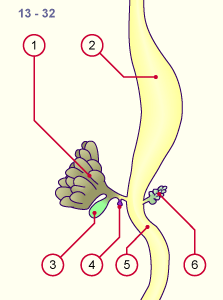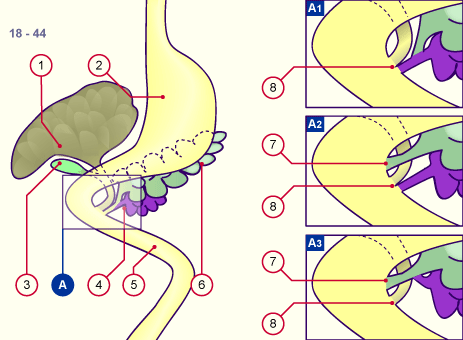|

|
|
|
|
The pancreas arises from two anlagen, both buddings of the endoderm at the level of the duodenal loop. Initially the dorsal pancreas (stage 12, ca. 31 days,  12 12 ) grows on the dorsal side of the duodenum into the mesoduodenum. ) grows on the dorsal side of the duodenum into the mesoduodenum.
Somewhat later the ventral pancreas appears as an evagination of the bile duct.
|
|
|
| The dorsal pancreas anlage expands relatively rapidly into the mesoduodenum below the large curvature of the stomach. It comes to lie with its tail-like part (cauda) near the spleen. Its outflow passage, which emerges from its head, normally fuses with the outflow passage of the ventral pancreas anlage to become the major pancreatic duct. These join with the bile duct and discharge into the major duodenal papilla. Sometimes the outflow passage of the dorsal pancreas anlage persists as an independent minor pancreatic duct and discharges somewhat more cranially at the minor duodenal papilla into the duodenum. |
|
Fig. 29 - Dorsal pancreas anlage stage 13, ca. 32 days |
|
Legend |
|

1
2
3
4
5
6 |
Liver anlage
Stomach
Gall bladder
Anlage of the ventral pancreas
Duodenum
Anlage of the dorsal pancreas |
|
|
|
Fig. 29
From the duodenal loop the liver-gall bladder anlage sprouts ventrally and somewhat later gives out the ventral pancreas anlage.The dorsal pancreas anlage emerges dorsally.
|
 |
 |
|
The ventral pancreas anlage arises somewhat later (stage 13-14, ca. 32-33 days,  13 13 ) as a budding from the bile duct. Due to the 90 degree rotation of the stomach and the lengthening of the duodenal loop the bile duct with the gall bladder and the ventral pancreas are moved towards the rear, thus rotating around the duodenum and reaches then a position ventral to the dorsal pancreas. In the adult pancreas the anterior part of the head (caput), the body (corpus) and the tail (cauda) thus stem from the dorsal part while the posterior part of the head as well as the uncinate process come from the ventral part. ) as a budding from the bile duct. Due to the 90 degree rotation of the stomach and the lengthening of the duodenal loop the bile duct with the gall bladder and the ventral pancreas are moved towards the rear, thus rotating around the duodenum and reaches then a position ventral to the dorsal pancreas. In the adult pancreas the anterior part of the head (caput), the body (corpus) and the tail (cauda) thus stem from the dorsal part while the posterior part of the head as well as the uncinate process come from the ventral part. |
|
|
|
The position of the orifice of the bile duct and that of the pancreas can vary considerably in adults. Usually the dorsal pancreatic duct opens into the ventral and this ends besides the bile duct at the major duodenal papilla into the duodenum (see figure).
|
|
|
| Fig. 30 - Orifice variations of the pancreatic duct |
|
Legend |

1
2
3
4
|
Liver
Stomach
Gall bladder
Ventral pancreas |
|
|
5
6
7
8 |
Duodenum
Dorsal pancreas
Minor duodenal papilla
Major duodenal papilla |
|
|
|
|
Fig. 30
The end portion of the original outflow passage of the dorsal pancreas obliterates and a connection to the ventral duct is established. (A1). Occasionally, however, the merging between the dorsal and ventral passages does not take place (A2). In another variant, the pancreatic duct of the ventral pancreas is annexed by the duct of the dorsal pancreas. The pancreas secretion flows into the minor duodenal papilla and that of the gall bladder into the major duodenal papilla (A3).
|
|
|
|
|
|

